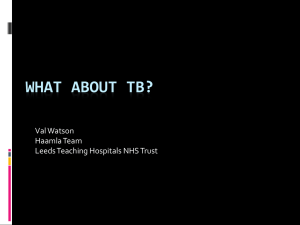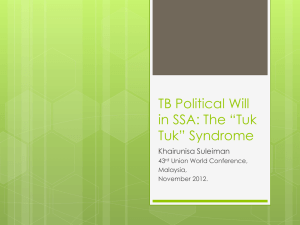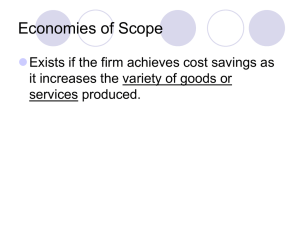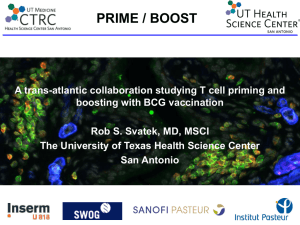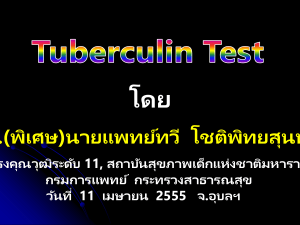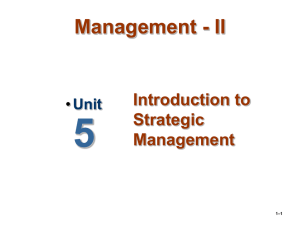Sask BCG Discontinuation
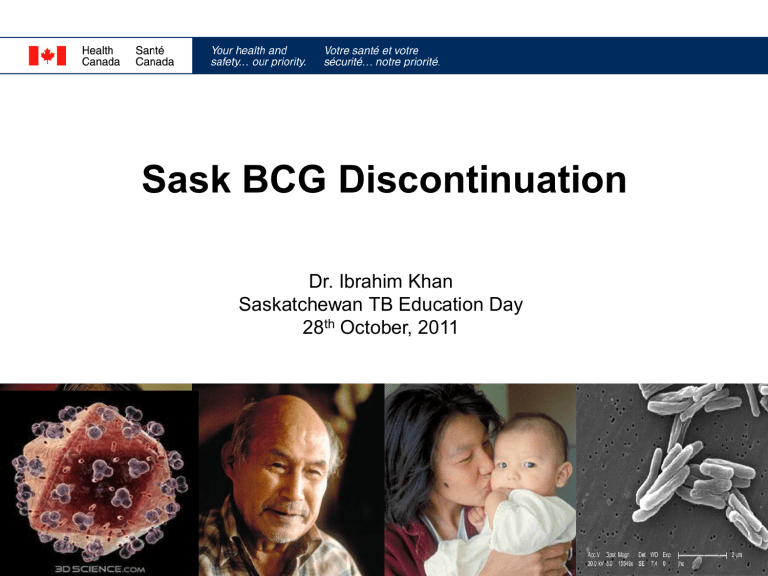
Sask BCG Discontinuation
Dr. Ibrahim Khan
Saskatchewan TB Education Day
28 th October, 2011
Overview
• Purpose
• Background
• Criteria for use/discontinuation of BCG
• Discussion
Purpose
• To provide an overview of the process that lead to the decision of BCG Discontinuation in the province of
Saskatchewan including on the First Nations reservations
Background
• The protective effect of BCG vaccine against TB meningitis and miliary TB in children has been well documented (86%).
• BCG protective effects against pulmonary tuberculosis are inconsistent ranging from 0% to 80%
• BCG does not prevent primary infection or reactivation of latent pulmonary infection.
• In summary, the impact of BCG vaccination on community transmission of TB is very limited.
Background ( continued….)
• BCG can cause disseminated BCG in children with underlying immunodeficiency.
• The estimated rate of disseminated BCG infection in First Nations and Inuit populations in Canada greatly exceeding global estimates.
• BCG vaccine has become a barrier to investigation of TB transmission after contact with TB case and effective use of preventive therapy.
• Prior to 2003, the majority of FN newborns living on reserve were offered BCG vaccine however the uptake of vaccine in some communities were zero or very low.
Background ( continued….)
• In 2003 FNIHB held a national forum “strengthening the Tuberculosis Control
Program” with a focus on use of BCG and other preventive program components.
The key conclusions:
– engaging FNs in any BCG policy changes
– taking cautious approach for implementing BCG discontinuation (on a community by community basis and based on epidemiology of TB in each community)
– considering the IUATLD criteria for discontinuation of BCG
– strengthen the overall TB control program including enhanced TB screening programs.
History of BCG Discontinuation in
Saskatchewan
• Oct 2005: Based on the IUATLD criteria, TBC and FNIH sask region decided to discontinue BCG in 27 First Nations communities in the south
• The decision included the commitment to annually review of TB epi (e.g., paediatric meningitis cases/ infectious cases in the communities), to enhance screening and aggressive contact trace in the communities
• January 2011 PAPHR decided to discontinue BCG
• TBC, FNIH, Ministry and Northern Health regions had series of focused meetings and epidemiological reviews to assess the situation and look at the practice of BCG in the rest of the
Province.
What is currently happening in terms of BCG practice?
Current practice of BCG in FN communities
BCG discontinued BCG is used
Atl
QC
ON
MB
33
27
104
2
0
0
32
62
SK All since Sept 11 0
AB 43 2
BC
Total
201
437 (73%)
0
159 (27%)
Report on Impact of the First Nations Inuit Health
Branch Policy Direction Change with regards to Use of BCG Vaccine in FN communities
Ezzat Farzad MD, MSc, FRCPC
Dennis Wardma MD, FRCPC,
Office of Community Medicine, FNIHB, Health Canada
Meeting of Aboriginal Sub-Committee of CTC
October 8, 2010
Impact of BCG Discontinuation
Purpose
• The primary purpose of this report is to examine the impact of the 2003 changes to FNIHB policy on use of BCG vaccine
Criteria for discontinuation of BCG (IUATLD)
• average annual notification rate of smear-positive pulmonary TB cases below 5 per 100,000 or less during the previous three years; or
• average annual notification rate of tuberculosis meningitis in children aged under five years below 1 per 10 million general population during the previous five years; or
• av erage annual risk of tuberculosis infection below 0.1% or less
Criteria for use of BCG (NACI)
• BCG vaccine may be considered for infants in First Nations and Inuit communities or infants residing among groups of persons with:
– an average annual rate of smear-positive pulmonary TB greater than
15 per 100,000 population (all ages) during the previous 3 years; or
– an annual risk of TB infection greater than 0.1% if early identification and treatment of TB infection are not available.
Indicators used for FNIHB study
• 3-years average annual rates of smear-positive pulmonary TB for all ages per
100, 000 population (IUATLD and NACI targets)
• 5-year average annual rate of TB meningitis among children under 5 years of age per 10 million general population ( IUATLD target)
• miliary TB among children under 5 years of age per 100,000 population
• Data for annual rate of TB infection” post BCG discontinuation was not available.
Source of information
• CTBRS (for smear positive pulmonary and miliary TB)
• FNIH regional data (for TB meningitis)
• personal communications.
Results: Number of cases and rates (per 100,000) of TB meningitis,
FNs on reserve
2000 2001 2002 2003 2004 2005 2006 2007 2008 Average rate 2004-
2008
Bellow
IUATLD
Criteria
QC
SK
Total
AB
BC
ON
0
0
0
0
1(12.0)
0
0
1(15.9)
0
0
0
1(2.0)
0
0
0
0
0
0
0
0
0
0
0
0
0
0
0
0
0
0
0
0
0
0
0
0
0
0
0
0
0
0
0
0
0
0
0
0
0
0
0
0
0
0
0
0
0
0
0
0
Yes
Yes
Yes
Yes
Yes
Yes
Discussion
• No case of children meningitis has been reported for onreserve FN children (5 years old or younger) during
2004-2008 (i.e. after discontinuation of BCG)
• The discontinuation of BCG in on-reserve FN communities has not resulted in an increase in the smear positive rates in most regions.
Conclusion and Recommendations
Given that BCG vaccine has very limited impact on community transmission of TB and TB control in general, and in light of favourable qualitative and quantitative reviews of the impact of the BCG discontinuation in most regions, it is recommended that the Branch and the regions continue in this direction with the following considerations:
• enhanced surveillance system to enable further monitoring of BCG discontinuation
• continuation of an effective TB program that includes early case finding, case management, contact tracing, surveillance, screening and etc.
• For regions who have smear positive rates higher than
IUATLD criteria or are showing an increasing trend after
BCG discontinuation, effective screening programs are required to protect children.
Saskatchewan Decision on BCG Discontinuation 2011
• Evidence base for optimal use of screening programs in children is weak and indeed the Canadian standards acknowledge that “The optimal design of such screening programs is being investigated.”
• This is further evidenced by wide variation in the way screening is delivered in different Provinces in Canada, particularly in relation to the ages when children are tested
Saskatchewan decision
In sask we are endorsing aggressive approach to contact tracing ensuring at least
• Thorough identification of contacts
• Identification and prioritisation of the vulnerable
• Identify those needing sputum samples, CXRs
• TBC assess within a month those needing assessment
• Priority not just to completion of treatment of active TB, but timely assessment, initiation and completion of treatment of LTBI when indicated, especially in children.
Recommendation of Sask TBWG
For Screening 2011 / 2012
• Age 1 and 2 in high risk northern communities identified by
NITHA
• School Entry all children in Saskatchewan First Nations and northern communities (within the 3 northern health regions/authorities)
• Grade 7 all children in Saskatchewan First Nations and northern communities (within the 3 northern health regions/authorities)
• In FNIH areas (south central) screening all children in
Kindergarten, grades 2 ,4 ,6 , and subject to annual epi review
Moving forward with TB program in sask
• Develop monitoring framework that present results by community and include:
• Numbers screened compared with population. denominator ( children age 1-4 and class size)
• TST positive requiring follow up
• % requiring follow up seen in clinic
• Numbers identified positive for latent or active TB
• status of those TST+
Moving Forward
*Additional resources been provided to Northern FNs for enhanced screening and contact tracing
*One robust and aggressive screening plan for all
*focus on enhanced education and awareness in the communities
Thanks for Your attention
Questions???
POPULATION HEALTH BRANCH
